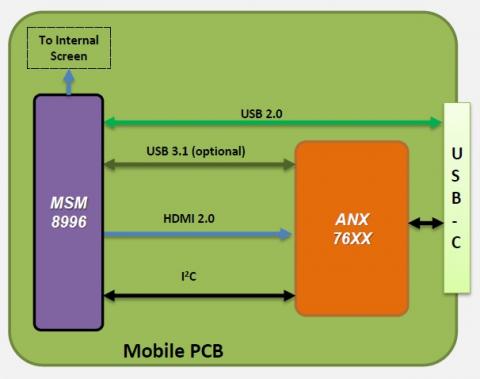Single chip lowers USB Type-C integration costs
By Caroline Hayes, October 26, 2015
Although first announced at CES in Las Vegas at the beginning of the year, the Nano-Console still caused a frisson of excitement at the Eurasia press meeting in California, where it was demonstrated in a presentation by Andre Bouwer, VP marketing at Analogix Semiconductor.The compact, wireless console uses SlimPort technology to link smartphones and tablets to large screens, to stream video and play games on large screens. It also has a small remote control which can be used to control mobile office tasks, such as presentations carried on a smartphone and displayed on a big screen, as well as to play video games and control over-the-top video and internet data.
The company designs and manufactures semiconductors for end-to-end interface connectivity for digital multimedia. Its SlimPort products are compliant with DisplayPort, the high performance, low cost video connectivity standard which is low power and which reduces the wire count in connecting multimedia devices. Currently, there are over 50million SlimPort-enabled mobile devices shipped including Google Nexus phones, ZTE Nubia models and Amazon Fire tablets.
The first announcement from the company was the ANX74XX family, an integrated USB Type-C implementation of the SlimPort family which support all configurations of USB data, power delivery and DisplayPort alternate modes (the de factor standard for sending video over the USB Type-C port adopted by Apple, Google and recommended by Microsoft for Windows 10.) A single chip contains a cable configuration controller, a port controller and manager, and a high-speed switch for USB 3 and DisplayPort. The high-speed switch includes patent-pending circuits to reduce signal attenuation so that no external redriver is required in the USB-C system.
The USB-C connector offers USB power delivery (USB-PD) up to 100W battery charging, SuperSpeed USB (USB 3) data transfer up to USB 3.1 Gen 1, 5Gbit/s, support for video DisplayPort alternate mode resolutions up to 4K and 8K.
The family consists of the ANX7428, optimal for X86 based notebooks. It offers four lanes of DisplayPort and SuperSpeed USB switching, DisplayPort Alternate Mode, USB-C port controller and power delivery. The ANX7418, optimised for ARM based smartphones, tablets and action cameras has two lanes of DisplayPort and SuperSpeed USB switching, DisplayPort Alternate Mode with SlimPort transmitter, USB-C port controller and power delivery. The ANX7408 has SuperSpeed USB switching with USB-C port controller and power delivery, the ANX7409 has SuperSpeed USB switching with USB-C port controller, the ANX7401 configuration is a USB-C port controller with power delivery and there is the ANX7403, with USB-C port controller.

The company announced the single chip ANX7688 (pictured), which it believes is the first device in the market to support cable detection. It further reduces the bill of materials in an ultra-high definition, 60HZ application.
USB Type-C cable will replace HDMI cables (and all USB cables), predicts Bouwer, and the company’s ANX74xx family will help manufacturers, with a unified hardware and software across device form factors.
